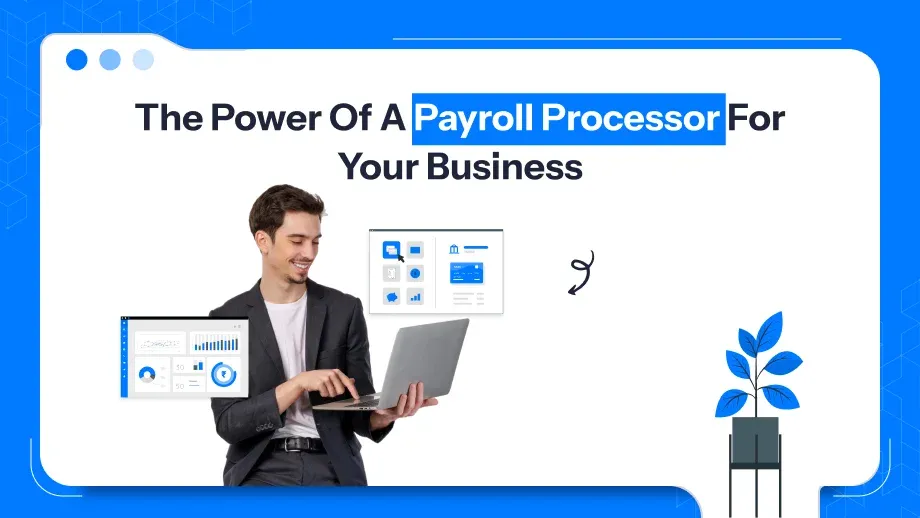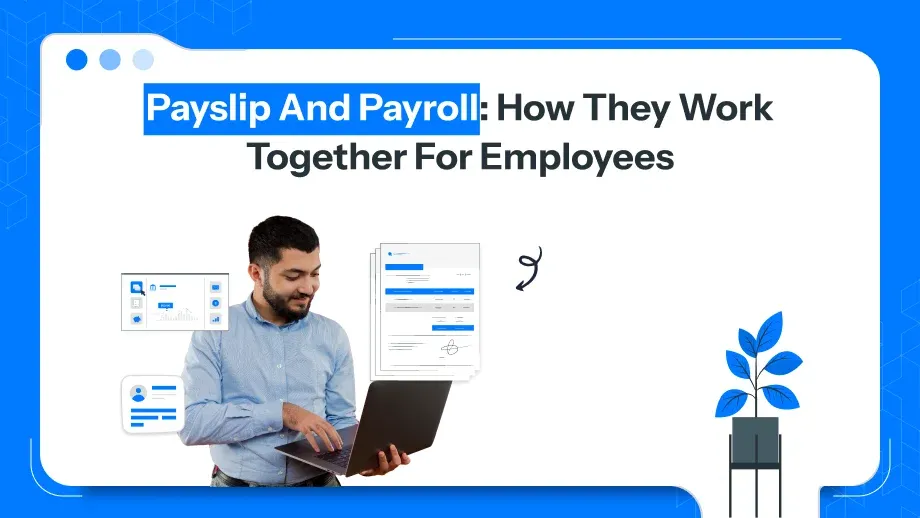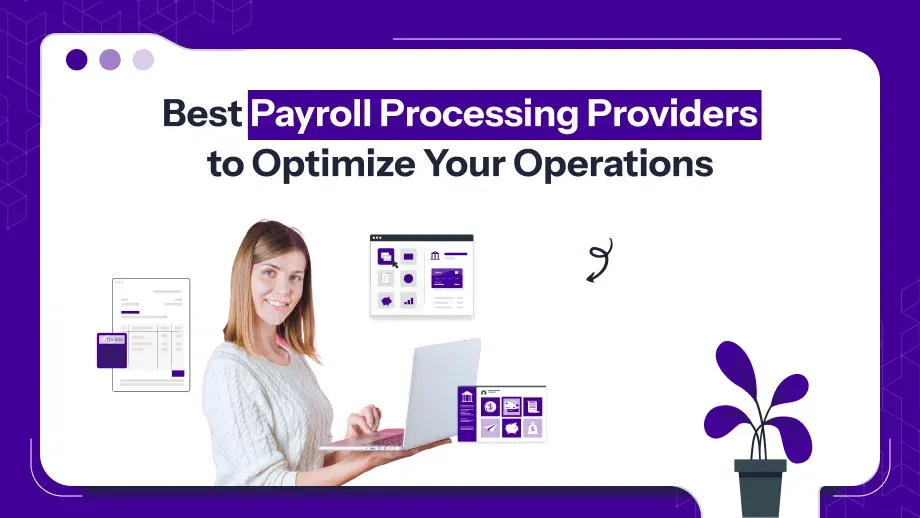
Payroll startups or large scale corporations, remain functional without taking payroll management functions seriously. As such, companies ensure that each employee is given the pay correctly on time under taxation law and according to proper recording. This is where a payroll processor plays a crucial role.
What is a Payroll Processor?
The person, program, or service in the position of managing and processing a company’s paycheck is known as a payroll processor. To put it simply, they are in charge of making certain that workers are paid on time in order to meet additional obligations like tax and legal problems.
As a payroll processor, it includes the tasks of computing wages of the employees, deduction of taxes, benefits and other withholdings, and processing of payroll records for future use.
Payroll processors help businesses avoid errors, avoid the risk of legal issues, and maintain a smooth payroll workflow. They could be internal staff members or third-party payroll services, depending on the needs of the business.
Key Functions of Payroll Processors
Employee Salary Calculation
Calculating wages for workers is one of a payroll processor’s most important duties. Although it might appear straightforward, there are a number of factors to take into consideration:
- Hourly The worker: Payroll suppliers keep account of all the hours worked by hourly workers during the pay period, including overtime, which is compensated at an increased rate than the norm. This can also involve keeping track of compensated time off, time off for illness, break time, and any other kind of absence that might have an effect on compensation.
- Salaried Employees: Salaries are paid regardless of the number of hours worked, but time off, bonuses, or commission that may have affected their pay during the pay period must be accounted for by the payroll processor.
- Overtime Computation: The overtime of non-exempt employees should also be computed based on the rules and regulations that are defined under the Fair Labor Standards Act. Generally, overtime is paid at 1.5 times the standard hourly rate for any hours worked beyond 40 in a week.
- Bonuses, Commissions, and Other Incentives: Payroll processors must add any bonuses, commissions, or performance incentives due to the employee. Sometimes this may be another calculation to ensure that all of these are covered in the paycheck.
Deductions and Benefits Management
Payroll processors not only prepare taxes but are also responsible for other payroll deductions, including:
- Retirement Contributions: Most companies provide retirement plans in the form of 401(k) or pension. Payroll processors will take off the contributions of employees to these funds, which sometimes have matching by the employer and ensure that those contributions are sent to the correct fund.
- Health Insurance and Other Benefits: For employees with health insurance or other benefits (such as dental, vision, life insurance), payroll processors deduct the necessary premiums from employee wages. This includes managing flexible spending accounts (FSAs) or health savings accounts (HSAs).
- Garnishments and Child Support: In case an employee is subject to wage garnishments for unpaid debts or child support, the payroll processor should make sure that the correct amount is deducted and remitted to the proper authorities.
- Other Voluntary Deductions: Some employees may want to make other voluntary deductions, such as charitable donations, union dues, or contributions to commuter benefits programs. The payroll processor ensures that these deductions are applied and properly accounted for.
Take the hassle out of payroll management with a trusted payroll processor.
Streamline your operations and ensure timely, accurate payments today!
Paycheck Disbursal
After calculating wages and applying all the deductions, the payroll disburse the pay to employees. There are a few different methods for doing this:
- Direct Deposit: Most organizations have direct deposit, which is the most efficient way that employees can receive their pay. Direct Deposit systems are set up and managed by payroll processors so that the correct amounts are transferred to each employee’s bank account on payday.
- Paper Checks: Businesses that still print paper checks get them printed and distributed by the payroll processor. They must guarantee that each employee gets the correct paycheck and at the right time.
- Pay Cards: Some employees are paid on a preloaded debit card. The payroll processor makes the payment through transferring funds to the appropriate cards.
- Pay Stubs and Documentation: Payroll system give employees detailed pay stubs or online access to their earnings statements. The pay stubs break down the total earnings, taxes withheld, deductions, and net pay, thus being transparent to the employees.
Paycheck Disbursal
After calculating wages and applying all the deductions, the payroll disburse the pay to employees. There are a few different methods for doing this:
- Direct Deposit: Most organizations have direct deposit, which is the most efficient way that employees can receive their pay. Direct Deposit systems are set up and managed by payroll processors so that the correct amounts are transferred to each employee’s bank account on payday.
- Paper Checks: Businesses that still print paper checks get them printed and distributed by the payroll processor. They must guarantee that each employee gets the correct paycheck and at the right time.
- Pay Cards: Some employees are paid on a preloaded debit card. The payroll processor makes the payment through transferring funds to the appropriate cards.
- Pay Stubs and Records: Payroll provide workers with internet access to their earnings reports or comprehensive pay stubs. Pay stub provides workers with clarity by breaking down total earnings, tax withheld, deductions, or net pay.
Reporting and Compliance
In this regard, the payroll will also be able to ensure that all reporting requirements from the businesses are in place and kept up-to-date, internal and external reporting as follows:
- Tax Reports: Reports on payroll taxes would be given, like the quarterly and annual reports for tax filing. Such reports include the quarterly federal tax return known as Form 941, and the annual wage and tax statement, or Form W-2.
- State and Local Filings: In some states, payroll processor file the payroll taxes. This may be state income tax withholding or state unemployment insurance taxes.
- Labor Law Compliance: Payroll processors ensure that a business is compliant with labor laws on minimum wage, overtime pay requirements, and paid leave laws. They check if the business is compliant both on the federal level and state level.
Payroll Processor Records: Why Are They Important?
There are several reasons why accurate payroll processor records are essential:
- Tax Filings: Payroll records are the foundation for tax filings. They generate payroll tax reports and necessary forms to file with federal and state agencies.
- Audit and Compliance: In case of an audit, businesses have to provide detailed payroll records that will help them show compliance with tax laws and employment regulations. Proper record-keeping makes the process much easier.
- Dispute Resolution: If a pay-deduction issue arises about any employee, there will be a record in payroll records to dispute and clear the issue. The accurate record builds transparency without misunderstandings.
- Access for Employees: Payroll records provide employee access as far as income, tax withholding, and deductions are concerned. It creates a favorable relationship between employers and employees.
Advantages of a Payroll processor
Payroll software saves time and increases the efficiency of the costs taken for the payroll processing to experts or payroll software. They reduce the manual efforts of payroll calculation and ensure that payroll tasks are indeed processed accurately and within due time.
- Accuracy and Compliance: Payroll processors remain updated with changing tax laws and regulations. Therefore,.
- Reduced Human Error: There are chances of calculation and deduction mistakes in manual payroll handling. Payroll service reduces the chances of such errors to a considerable extent that could lead to a costly mistake.
- Access to expert knowledge: Professional payroll processor specialized knowledge on tax laws, deductions, and record-keeping ensures that businesses’ payroll is not being compromised with other operational core processes.
Choosing the Right Payroll Processor
The most significant decision for any business is the correct selection of a payroll processor. For a small startup to a large corporation, the payroll process must be accurate, timely, and compliant with legal requirements.
Assess Your Business Needs
It is important that you assess the needs of your business before actually starting to consider the various payroll processor. Right solution for the business will depend upon factors such as size of its workforce, payroll complexity, and also its growth plan.
Cost and Budget Considerations
Cost and Budget are always at the forefront in choosing a payroll processor. Some payroll services differ in terms of their services, features, as well as payroll for service levels, causing differences in terms of prices as well.
Usability and Interface Integration
A payroll processor must be friendly if you and your team members are not payroll professionals. The less effort you waste figuring out hard features or even correcting errors because they are a result of poorly constructed software.
Tax Compliance and Reporting
Tax rules keep changing; maintaining compliance might not be simple. A credible payroll processor would keep your business abreast with changes in federal, state, or local tax codes and regulations.
Employee Self-Service Features
One such feature that most businesses tend to overlook would be employee access to payroll information. This will reduce the administrative burden on your HR or payroll processor department since employees can access their pay stubs, tax information, and other details regarding benefits.
Customer Support and Service
Even the best payroll processor can make mistakes, so it is essential to have a reliable customer support provider. See that the provider offers multiple channels for support such as phone, email, and live chat in addition to offering assistance during business hours.
Conclusion
A reliable payroll processor is very important for businesses of all sizes, so that the payroll management is smooth, accurate, and compliant. A good payroll simplifies what otherwise might be complicated tasks, such as calculating wages, managing taxes, and keeping accurate records. Be it simple software solution or comprehensive third-party service, whether you have opted for either of these or a third one, an ideal payroll processor avoids errors, thus keeping away the possibility of costly compliance issues while saving time and administrative effort.







